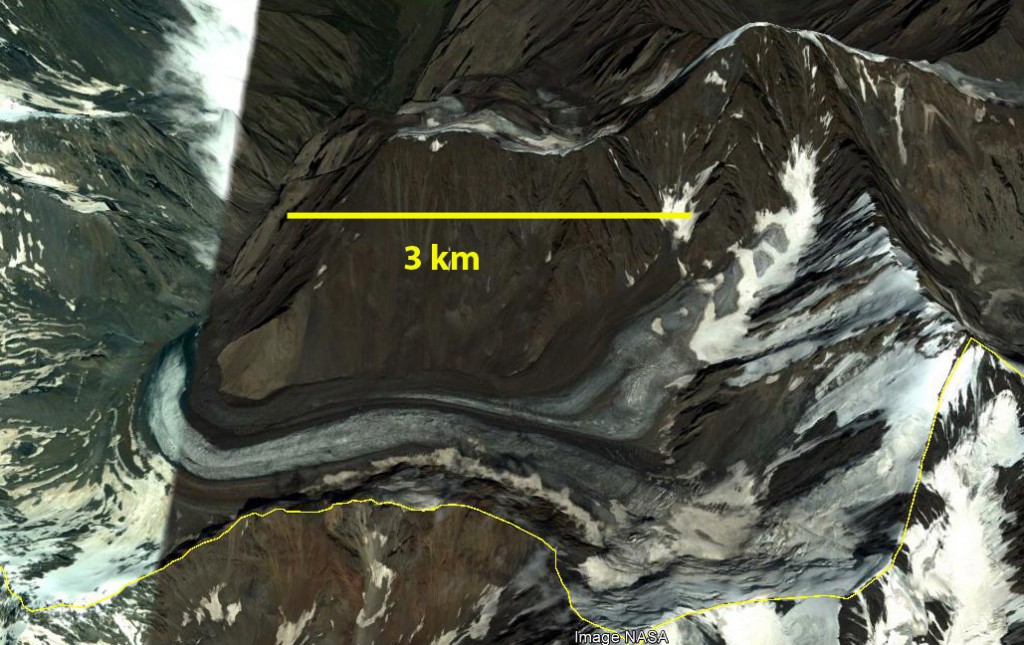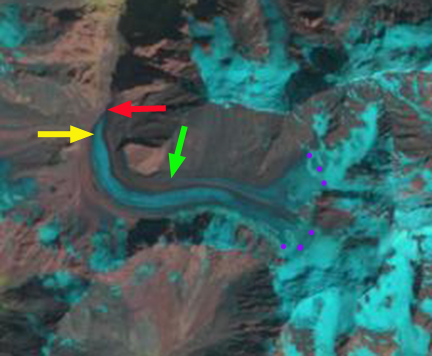July 30, 2015
Lednik Midagrabin Retreat, Caucasus, Russia
Posted by Mauri Pelto
Lednik Midagrabin is a large glacier draining northwest from Gora Dzhimara in North Ossetia, Russia. Stokes et al (2006) examined Caucasus glaciers during the 1985-2000 period and found that 94% of the glaciers have retreated, 4% exhibited no overall change and 2% advanced. The mean retreat rate is 8 m/year, with the largest glacier retreating the fastest. Shahgedanova et al (2009) observed that the retreat was driven by a large rise in summer temperature in the alpine zone, and that this will continue and generate substantial changes in the timing and amount of glacier runoff. Here we examine the changes in this glacier from 1989-2015. This region has had a particularly warm start to the melt season in 2015 prompting this examination, note the NOAA temperature anomaly for the Caucasus Region.
Google Earth Image
NOAA 2015 Temperature departure map for June 2015 with the Caucasus region indicated.
The glacier begins on the slopes of Dzhimarra at 4200 m and in 1989 the glacier terminated at the red arrow at 2950 m. The snowline at the end of August, 1989 was 3700 m. The green arrow indicates the extent of the clean blue glacier ice of the tributary from the north In 2014 the glacier had retreated to a terminus location at the red arrow. The snowline at the end of August 2014 was at 3800 m. In mid-July of 2015 the snowline has already reached 3700 m, with the melt season only half over. This will lead to substantial mass loss. The main terminus has retreated to the yellow arrow a distance of 900-1000 m since 1989 and now terminates at 3050 m. This is close to the maximum rate of 38 m/year identified by Stokes et al (2006) for the any glacier in the mountain range from 1985-2000. This indicates Midagrabin is one of the faster retreating glaciers in the Caucasus and that the rate of retreat has increased. The northern tributary clean ice zone has been reduced in length and width, now terminating 600 m further upglacier. The northern tributary has had little retained snowpack in 2014 and again in 2015. The tributary begins at 4000 m, which is not high enough in recent years to sustain this arm of the glacier. The high snowlines of recent years will lead to continued retreat. The glacier poses little geologic hazards of flooding compared to some other retreating glaciers in the area such as Bashkara Glacier.
August 1989 Landsat Image
August 2014 Landsat Image
July 2015 Landsat image







 Dean of Academic Affairs at Nichols College and Professor of Environmental Science at Nichols College in Massachusetts since 1989. Glaciologist directing the North Cascade Glacier Climate Project since 1984. This project monitors the mass balance and behavior of more glaciers than any other in North America.
Dean of Academic Affairs at Nichols College and Professor of Environmental Science at Nichols College in Massachusetts since 1989. Glaciologist directing the North Cascade Glacier Climate Project since 1984. This project monitors the mass balance and behavior of more glaciers than any other in North America.